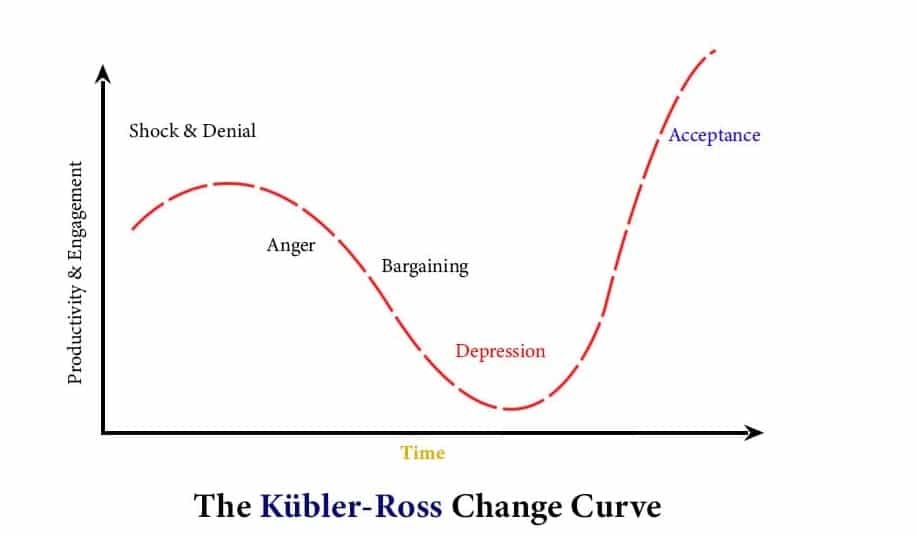The Kübler-Ross Model (also known as the “Five Stages of Grief” or “DABDA”) is a psychological model which states that people who experience grief go through five stages of emotions: (1) denial, (2) anger, (3) bargaining, (4) depression, and (5) acceptance.
Swiss-American psychiatrist Elisabeth Kübler-Ross introduced this model in her 1969 book, On Death and Dying. She identified the five stages of grief as “defense mechanisms” or “coping mechanisms” used to handle change, loss, and shock. At that time, there was no book to guide medical professionals in understanding the condition that patients experienced on their deathbeds.
This model results from her work with terminally ill patients. Kübler-Ross saw her patients experiencing these stages while coping with illness and dying.
You might be wondering why I wrote an article on the medical profession. Well, businesses undergoing major changes extensively use the Kübler-Ross Model Curve.
The change curve (or Kübler-Ross change curve) is a great tool for change managers to understand the psychology of staff who resist changes and want the status quo.
I have authored several articles on change management (e.g., change management vs. project management and change management vs. release management).
In these articles, I have discussed the different stages people go through while implementing the changes.
Understanding the Kübler-Ross Model can greatly help you understand the above topics.
Let’s get started.
The Kübler-Ross Stages of Grief

Kübler-Ross’ Five Stages of Grief are listed below.
#1. Denial
This stage is also known as the stage of disbelief. In this stage, individuals believe the diagnosis is wrong and avoid reality. They may isolate themselves and not discuss the problems. This is a temporary defense mechanism to protect the psychological mind.
This stage helps individuals survive the loss. Individuals are in shock because the life they once knew has suddenly changed.
Here, individuals may think, “Why me?” “I feel fine,” “This cannot happen to me,” etc. This feeling is replaced with a heightened awareness of situations after the initial shock subsides.
#2. Anger
When individuals realize that denial cannot continue, they become frustrated and show signs of anger. They may lash out at their immediate relatives or medical staff.
The relatives need to be patient and understand the situation the patient is passing and not take the anger personally.
In this stage, individuals may think, “Why me?” and “Life is unfair.” They may also blame others for their illness.
This is an important stage in which individuals can feel anger. The sooner they feel anger, the sooner it disappears.
Suppressing the anger and letting it control the individual is not advisable. A trained counselor must counsel individuals if they struggle to control their anger.
#3. Bargaining
When in trouble, individuals make deals with God. For example, please let me pass the exam, and I will donate 100 USD to the poor. This is bargaining. Bargaining provides false hope that individuals can avoid grief with this negotiation.
Guilt is common in this phase. For example, I would have passed the exam if I could have studied longer.
Patients facing less serious illness can seek compromise. For example, they can bargain for more time to live in exchange for a reformed life.
In this stage, individuals may think, “God, if you can heal me, I will turn my life around.”
“I promise to be better if you will let me live.”
#4. Depression
Depression is a reaction to an individual’s emptiness when diagnosed with a terminal illness. Individuals withdraw from life. They are hopeless and may encounter suicidal thoughts.
They become silent, avoid public contact, and spend most time alone in grief.
Patients know they will die, become silent, refuse meetings with anyone, and spend much time crying and grieving.
In this depression stage, the individuals may think, “I’m so disappointed?”; “I am going to die,” and “What is the point?”
#5. Acceptance
In this last stage, individuals accept mortality. The person comes to terms with their death and prepares to let go. Here, the emotion is stable.
In this stage, the emotions stabilize, and individuals re-enter reality. They realize they are going to die, and they can move forward.
Individuals come out of isolation, engage with friends and family, and start living the rest of their lives peacefully.
In this stage, individuals may think, “This is my destiny,” “It is going to be okay,” and “I can’t fight it.”
Symptoms of Grief
Some common symptoms of grief are:
- Guilt
- Stress
- Worry
- Sadness
- Anxiety
- Frustration
- Difficulty Sleeping
- Detachment
- Anger
- Loss of Appetite
- Aches and Pains
- Isolation from Friends and Family
Drawbacks of the Kübler-Ross Model
A few drawbacks of the Kübler-Ross Model are:
- Cultural and Individual Differences: The stages may not universally apply across different cultures, religions, or individual belief systems because grief responses are influenced by various factors (e.g., cultural norms, personal values, religious beliefs, and social-support systems).
- Inadequate Representation of Long-Term Grief: The Kübler-Ross Model focuses on the immediate aftermath of loss, and as such, it does not account for the long-term grieving process. Grief is a lifelong journey, and individuals may experience ongoing emotional, psychological, and social challenges beyond the five stages identified in the model.
- Empirical Evidence: This model is not based on empirical evidence. It was developed through Kübler-Ross’ observations of terminally ill patients and has not been tested scientifically.
- Does Not Consider Complex Grief: The model suggests that grief is a linear process when it is more complex and fluid in reality. Individuals may move back and forth between different stages or not experience all the stages.
- Can Be Stigmatizing: The model can be seen as stigmatizing. It suggests that there is a “right” way to grieve and that individuals who do not follow the model are “abnormal.”
Grief Intervention and Treatment
Some common treatments and interventions for grief include:
- Supportive Counseling: This is the most important treatment for grief. It provides a safe and empathetic space for individuals to express their feelings and explore their grief. A trained counselor guides and supports the grieving process.
- Cognitive-Behavioral Therapy (CBT): This therapy helps individuals identify and challenge negative thoughts. It helps them develop coping strategies and adapt to the loss.
- Group Therapy: Participating in support-group sessions with others who have experienced similar losses can provide a sense of belonging and validation. Sharing experiences and emotions with others is comforting and helps the healing process.
- Mindfulness-Based Interventions: Meditation, deep breathing, and mindfulness exercises can improve thoughts and emotions. These techniques can promote acceptance and reduce grief-related distress.
- Expressive Therapy: Creative outlets (e.g., art therapy, music therapy, or writing) can provide a means of self-expression and emotional release. These activities can help individuals process their grief in non-verbal and symbolic ways.
- Medication: If the above methods do not provide fruitful results, therapists can offer medication to reduce depression and anxiety and/or improve their patients’ sleep.
How the Kübler-Ross Model is Useful in Project Management
The Kübler-Ross Model is useful for businesses that are undergoing a transition. Change managers can seek to understand their employees by using the Kübler-Ross Model and apply the changes with minimal resistance.
The Kübler-Ross Model is useful for project management in the following way:
Change Awareness
Denial is the first stage in the Kübler-Ross Model. This is similar to a reluctance to accept new project goals or directions in project management. By recognizing this stage, project managers can address resistance by clearly communicating the need for change, sharing project objectives, and addressing concerns and uncertainties.
Emotional Response
The model progresses from denial to acceptance. During these stages, team members may display frustration, resistance, or attempts to negotiate or find alternatives to the proposed changes. Project managers should empathize with team members’ emotions and provide a supportive environment for expressing and addressing concerns constructively.
Transition and Adaptation
The fourth stage is depression/sadness. In this stage, individuals feel loss and disengagement. In project management, this happens when team members realize that the old ways of working are no longer applicable and change is imminent. Project managers should support and guide the team during this transitional period by communicating the benefits of the change and facilitating training to help team members gain new skills and knowledge.
Acceptance and Integration
Acceptance is the final stage of the Kübler-Ross Model. In this stage, individuals come to terms with reality. In project management, this stage signifies the successful integration of new processes, tools, or methodologies within the project team. Project managers can reinforce this stage by recognizing and rewarding team members who have adapted and shown a positive attitude toward the change.
Summary
The Kübler-Ross Model is helpful in change management. Change managers or project managers can use it to understand the psychology of their employees and team members and then implement the change accordingly.

I am Mohammad Fahad Usmani, B.E. PMP, PMI-RMP. I have been blogging on project management topics since 2011. To date, thousands of professionals have passed the PMP exam using my resources.







